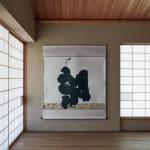Inoue Yūichi (1916–1985)
Setsu
Ink on Japanese paper and newspaper, hanging scroll
With a label signed by Unagami Masaomi
120 x 143 cm
170 x 146 cm (overall)
Exhibitions
The Eighth Bokujin Group Exhibition. Kyoto: Kyoto Municipal Museum of Art; Nagoya: Aichi Cultural Center, 1959.The Tokyo Air Raid, March 10th. Yu-ichi Inoue Tokyo: The Sumida River Side Hall, 2010.
Literature
Bokujin. No. 85. January 1960, 7.YU-ICHI [Yu-ichi INOUE] Catalogue Raisonné of the Works 1949–1985. Vol. 1. Tokyo: UNAC TOKYO, 1998.
A single kanji character, setsu (an instant), is drawn with nerizumi (paste ink) on gasen paper (a type of traditional Japanese paper for calligraphy made from wood pulp and rice straw) and mounted as a hanging scroll. The character extends onto a sheet of newspaper glued to the lower part of the work. Looking more closely, the viewer may also observe that the gasen paper consists of two or more separate sheets of different size, joined together in the middle.
Aiming for a dynamic effect, Inoue Yuichi shifted his interest to the single character written on large surfaces and incorporated media with bolder materials in the late 1950s. No longer satisfied with regular paper sizes, he began making his own paper. Yuichi was also fastidious about ink; he was fond of korizumi (frozen ink), which he left outside overnight in the winter to produce a more glutinous quality, resulting in a vivid trail of the brushstroke. Other choices include bond-zumi (gluey ink), a mixture of ink and glue, and the nerizumi he employed in this work, a variety where he would adjust the ratio of water and ink as he deemed fit for the character he was working on.
Yuichi has been widely known as an improvisator in art making. In the present work, it strikes the eye how he interconnects stillness and movement with a quick and rhythmical brush. The paper saturated with thick ink evokes a sense of tension that is typical of Yuichi’s emotionally charged writing style. Yet in their essence his works are not limited by the singularity of the place and time of improvisation, but rather in a philosophical sense Yuichi is probing into the nature of eventuality. A few drops of ink on the upper left part of the surface suggest that the artist probably started from here. The thick yet still fluid ink sweeps over the surface and reaches the newspapers which Yuichi perhaps had intended to protect the floor while he was working In a way, he submits the brush to the temporal order while at the same time gives it free reign to transcend common spatial restrictions. Maybe this is why the present work tells us a lot about Yuichi’s aspirations. To reach ultimate freedom and shed off one’s shackles and worldly restrictions in a mere instant is an ideal well represented by the character setsu, “an instant.”
Inoue Yuichi (calligrapher; 1916–1985)
Born in Tokyo, Inoue studied calligraphy under Ueda Sokyu, an avant-garde calligrapher who also mentored Morita Shiryu. Inoue co-founded the calligraphers’ group Bokujinkai. His large-scale, experimental calligraphy of single Chinese characters resonated strongly with the concurrent movement of Abstract Expressionism and breathed new life into the calligraphy world in Japan. Regarded as daring and innovative, his works were widely exhibited in Japan and abroad, including Documenta 2 in Kassel (1959) and the São Paulo Biennial (1957, 1961).
Aiming for a dynamic effect, Inoue Yuichi shifted his interest to the single character written on large surfaces and incorporated media with bolder materials in the late 1950s. No longer satisfied with regular paper sizes, he began making his own paper. Yuichi was also fastidious about ink; he was fond of korizumi (frozen ink), which he left outside overnight in the winter to produce a more glutinous quality, resulting in a vivid trail of the brushstroke. Other choices include bond-zumi (gluey ink), a mixture of ink and glue, and the nerizumi he employed in this work, a variety where he would adjust the ratio of water and ink as he deemed fit for the character he was working on.
Yuichi has been widely known as an improvisator in art making. In the present work, it strikes the eye how he interconnects stillness and movement with a quick and rhythmical brush. The paper saturated with thick ink evokes a sense of tension that is typical of Yuichi’s emotionally charged writing style. Yet in their essence his works are not limited by the singularity of the place and time of improvisation, but rather in a philosophical sense Yuichi is probing into the nature of eventuality. A few drops of ink on the upper left part of the surface suggest that the artist probably started from here. The thick yet still fluid ink sweeps over the surface and reaches the newspapers which Yuichi perhaps had intended to protect the floor while he was working In a way, he submits the brush to the temporal order while at the same time gives it free reign to transcend common spatial restrictions. Maybe this is why the present work tells us a lot about Yuichi’s aspirations. To reach ultimate freedom and shed off one’s shackles and worldly restrictions in a mere instant is an ideal well represented by the character setsu, “an instant.”
Inoue Yuichi (calligrapher; 1916–1985)
Born in Tokyo, Inoue studied calligraphy under Ueda Sokyu, an avant-garde calligrapher who also mentored Morita Shiryu. Inoue co-founded the calligraphers’ group Bokujinkai. His large-scale, experimental calligraphy of single Chinese characters resonated strongly with the concurrent movement of Abstract Expressionism and breathed new life into the calligraphy world in Japan. Regarded as daring and innovative, his works were widely exhibited in Japan and abroad, including Documenta 2 in Kassel (1959) and the São Paulo Biennial (1957, 1961).



